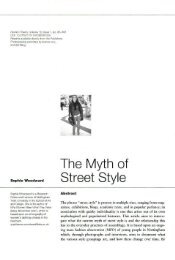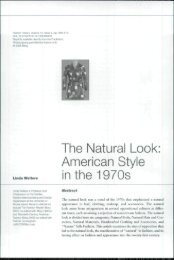Spinning the Ephemeral PDF - SMU Fashion Media
Spinning the Ephemeral PDF - SMU Fashion Media
Spinning the Ephemeral PDF - SMU Fashion Media
You also want an ePaper? Increase the reach of your titles
YUMPU automatically turns print PDFs into web optimized ePapers that Google loves.
294 Fiona Anderson<br />
IWeed, Landscape, and Modernity<br />
The design of <strong>the</strong>se textiles might <strong>the</strong>n be considered as constituting a<br />
blending, or intermingling of <strong>the</strong> dynamics of fashion and urban sartorial<br />
tastes and lifestyles, with rural environments and contexts. It is tempting<br />
to view this scenario simply as <strong>the</strong> mixing of contradictory, or opposing<br />
elements. Most recent literature on fashion has quite rightly posited strong<br />
connections between fashion, urbanization, and modernity. The move of<br />
vast sections of first <strong>the</strong> British and <strong>the</strong>n <strong>the</strong> European population into<br />
urban contexts from <strong>the</strong> late eighteenth century onwards has been seen<br />
to have greatly heightened <strong>the</strong> importance of appearances and <strong>the</strong>refore<br />
fashion within social life. Urban contexts have also been seen as pivotal<br />
to <strong>the</strong> rise of newly sophisticated and dynamic ways of making, promoting,<br />
and selling fashion, particularly from <strong>the</strong> late nineteenth century<br />
onwards (Breward 1999; Entwhistle 2000; Lehmann 2000; Wilson 1985).<br />
The conception that modern fashion is an urban phenomenon <strong>the</strong>refore<br />
underpins most recent publication on <strong>the</strong> subject and I do not wish to<br />
contest <strong>the</strong> broad significanceor relevance of <strong>the</strong>se arguments. However,<br />
exploring <strong>the</strong> history of tweed as an ephemeral fashion textile within <strong>the</strong><br />
context of recent literature from cultural geography, empire studies and<br />
gender studies presents interesting new perspectives about <strong>the</strong> relationship<br />
between fashion in modernity and urban and rural landscapes.<br />
For example, as Matless (1998) argues in Landscape and Englishness,<br />
owing to <strong>the</strong> integral relationships between industrialization, urbanization,<br />
and modernity, conceptions of <strong>the</strong> rural are often understood in<br />
direct opposition to this, in o<strong>the</strong>r words in <strong>the</strong> one-dimensional sense of<br />
being anti-modern and traditional. Clearly, in order to explore in more<br />
depth <strong>the</strong> widespread popularity in <strong>the</strong> late nineteenth century of tweed<br />
designs that reference rural landscapes it is necessary to examine contemporary<br />
views and engagement with ideas of <strong>the</strong> rural at that time.<br />
Recent research within <strong>the</strong> study of landscape has focused on it as a<br />
process linked to <strong>the</strong> formation of social and subjective identities. For<br />
example, in 2003 <strong>the</strong> editors of <strong>the</strong> Handbook of Cultural Geography<br />
argued that:<br />
<strong>the</strong> idea of a fixed identity unambiguously belonging to one group<br />
and unambiguously expressed in space has been replaced by notions<br />
of more fluid identities belonging to particular subject positions<br />
which can vary in intensity and can be combined in many different<br />
ways, so challenging homologous explanations (Anderson et al.<br />
2003: 7).<br />
These ideas show clear links with recent developments within multidisciplinary<br />
work on fashion and identity. In addition, W. J. T. Mitchell<br />
in his book Landscape and Power argues that "Landscape is a dynamic<br />
medium, in which we 'live and move and have our being,' but also a




